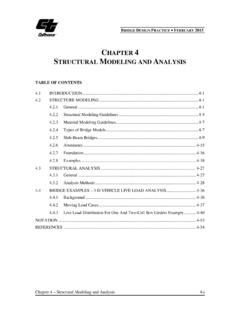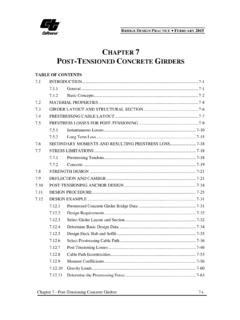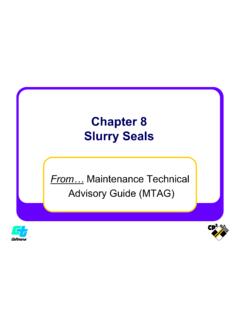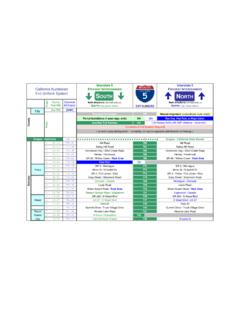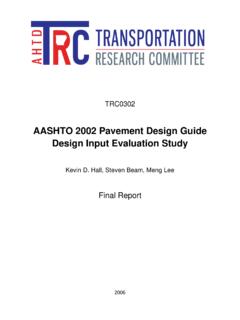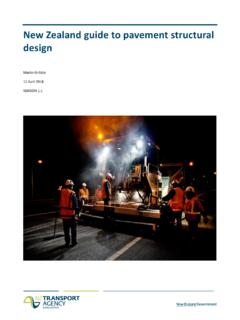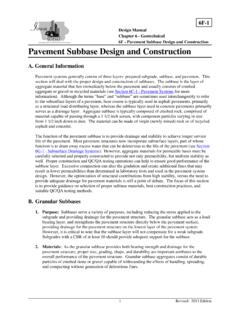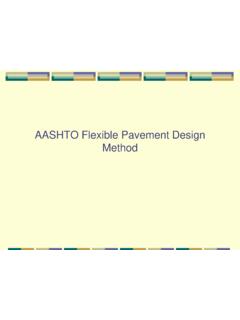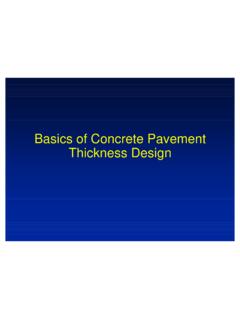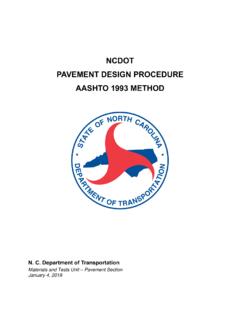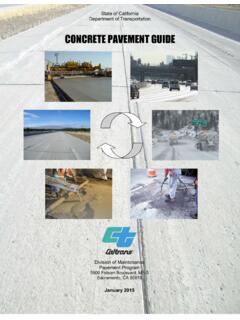Transcription of Topic 612 - Pavement Design Life
1 HIGHWAY Design MANUAL 610-1 November 20, 2017 CHAPTER 610 Pavement ENGINEERING CONSIDERATIONS Topic 611 - Factors In Selecting Pavement Type Pavement Type Selection The types of Pavement generally considered for new construction, widening, reconstruction, and rehabilitation in California are rigid, flexible and composite pavements. Rigid and flexible pavements are considered for all new and reconstructed pavements. For widening and rehabilitation projects, flexible or rigid pavements may be appropriate based on performance, maintainability, and constructability of new and/or existing Pavement structure. Composite Pavement consisting of a flexible layer placed over a rigid Pavement has mostly been used for maintenance and rehabilitation of rigid pavements on State highway facilities.
2 Life-cycle cost analysis discussed in Topic 619 is a useful tool when selecting optimal Pavement structure type for a specific project. Selection Criteria Because physical conditions and other factors considered in selecting Pavement type vary significantly from location to location, the Project Engineer must evaluate each project individually to determine the most appropriate and cost-effective Pavement type to be used. The evaluation should be based on good engineering judgment utilizing the best information available during the planning and Design phases of the project together with a systematic consideration of the following project specific conditions: Pavement Design life Traffic considerations Soils characteristics Climate Existing Pavement type and condition Availability of materials Recycling Maintainability Constructability Life-cycle cost analysis Life-cycle assessment The above factors should be thoroughly investigated when selecting a Pavement structure and addressed specifically in all project documents (PID, PR, PS&E, etc.)
3 The final decision on Pavement type should be the most economical Design based on life-cycle cost analysis (see Topic 619). In addition, the Department is currently developing a tool based on life-cycle assessment that can be valuable in selecting Pavement type and rehabilitation strategies while assisting the Department in achieving its sustainability goal (see Topic 620). The principal factors considered in selecting Pavement structures are discussed in Topic 612 through Topic 620. Topic 612 - Pavement Design Life Definition Pavement Design life, also referred to as performance period, is the period of time that a newly constructed or rehabilitated Pavement is engineered to perform before reaching any of the performance thresholds in Table for concrete pavements or those in Index for asphalt pavements.
4 The selected Pavement Design life varies depending on the characteristics of the highway facility, the objective of the project, and projected traffic volume and loading. The Pavement structure selected for any project should provide the minimum Pavement Design life that meets or exceeds the objective of the project as described in Index through Index New Construction and Reconstruction The Pavement Design life for new construction and reconstruction projects shall be no less than 40 years. For roadside facilities such as parking lots and rest areas, 20-year Pavement Design life may be used. Realignments or other new roadways which fit the definition of spot improvement in DIB 79 are 610-2 HIGHWAY Design MANUAL November 20, 2017 considered to be rehabilitation for purposes of determining Pavement Design life.
5 Widening Additional consideration is needed when determining the Design life for Pavement widening. Factors to consider include the remaining service life of the adjacent Pavement , planned future projects (including maintenance and rehabilitation), and future corridor plans for any additional widening. The Pavement Design life for the mainline traveled way, ramp traveled way, and intersection widening projects shall either be: (a) the remaining Pavement service life of the adjacent roadway (but not less than the project Design period as defined in Index ), (b) 20 years, or (c) 40 years depending on which Pavement Design life produces the lowest life-cycle costs.
6 Design the first 2 feet of new shoulder Pavement structure in conjunction with the lane widening, or if the shoulder is expected to be converted to a traffic lane within the Pavement Design life, Design the Pavement structure to match the same Pavement Design life as the adjacent traveled way. All other widening projects including shoulder widening and roadside facilities should be designed to either match the adjacent existing Pavement structure or a 20-year Design life, depending on the Design life that produces the lowest life-cycle cost. Life-cycle cost analysis is discussed in Topic 619. Pavement Preservation (1) Preventive Maintenance. Because preventive maintenance projects involve non-structural overlays, seals, grinds, or repairs, they are not engineered to meet a minimum structural Design life like other types of Pavement projects.
7 Their intended goal is to extend the service life and maintain ride quality of an existing Pavement structure while it is in good condition. On average, the added service life can vary from a couple of years to over 7 years, depending on the strategy being used and the condition of the existing Pavement . (2) Capital Preventive Maintenance. The strategies used for CAPM projects have been engineered to extend the service life and maintain ride quality of a Pavement that exhibits minor distress and/or triggered ride issues (International Roughness Index (IRI) greater than 170 inches per mile) by a minimum of 5 years. When properly engineered and placed on pavements that meet CAPM thresholds, CAPM strategies can last 5 to less than 20 years.
8 Roadway Rehabilitation The minimum Pavement Design life for roadway rehabilitation projects shall be 20 years except for roadways with existing rigid pavements or with a current Annual Average Daily Traffic (AADT) of at least 12,000 vehicles, where the minimum Pavement Design life shall be either 20 or 40 years depending on which Design life has the lowest life-cycle costs. At the discretion of the District, a 40-year Pavement Design life may be considered and evaluated for all projects with an AADT less than 12,000 using the Department s life-cycle cost analysis procedures. Life-cycle cost analysis is discussed further in Topic 619. Temporary Pavements and Detours Temporary pavements and detours should be engineered to accommodate the anticipated traffic loading that the Pavement will experience during the construction period.
9 This period may range from a few months to several years depending on the type, size and complexity of the project. Temporary Pavement should not be designed to the same depth as the new traveled way and should not require treated base. Non-Structural Wearing Courses As described in Index (5), a non-structural wearing course is used on some pavements to ensure that the underlying layers will be protected from wear and tear from tire/ Pavement interaction and environmental factors for the intended Design life of the Pavement . Because non-structural wearing courses are not considered to contribute to Pavement structural capacity, they are not expected to meet the same Design life criteria as the structural layers.
10 However, when selecting materials, mix designs and thickness of these courses, appropriate evaluation and sound engineering judgment should be used to optimize performance and minimize the need for maintenance of the wearing course and the underlying structural layers. Based on experience, a properly engineered non-structural wearing course placed on new or rehabilitated Pavement should perform adequately for 10 or more years, and 5 or HIGHWAY Design MANUAL 610-3 November 20, 2017 more years when placed on existing Pavement as a part of Pavement preservation. Topic 613 - Traffic Considerations Overview Pavements are engineered to carry the truck traffic loads expected during the Pavement Design life.


